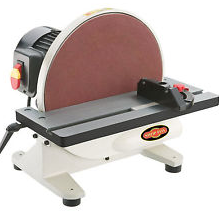I wouldn't try coating an aluminum wheel to be a contact wheel. Surely any coating will come loose the instant you put any pressure on it. Proper contact wheels are solid rubber and they do wear.
From the sanders I have used over the years, I think "hogging" with a 1/3hp motor is quite optimistic. In my experience 1" wide sanders are best suited to more fine work such as gently breaking a sharp edge and getting into tight spots.
This is an example of a 1/3 hp 1" wide belt sander
http://www.harborfreight.com/1-in-x-30-in-belt-sander-61728.html I have this sander but it says Delta on the side instead.
I also have this one
http://www.harborfreight.com/4-inch-x-36-inch-belt-6-inch-disc-sander-97181.html that also says Delta on the side. There is no hogging with this one either (except with wood).
I fear you will be spending a lot of time and money in an effort to use some free material and will ultimately be disappointed with the results (been there, done that). Now if you were to put a variable speed treadmill motor on it, that would be a worthwhile project. Check out some of the "knife making" 2x72" belt sander plans and videos for some interesting ideas.
Sorry if this sounds negative, I try really hard not to be. I have spent a fair amount of time running thought experiments on building a sander, and if you had no other projects to do, it might be a fun build. However, I think any free time you have will yield more satisfying results checking off any of the other items on your to do list.
It would be a much simpler project to make a disc only sander. Probably could go direct drive (depending on motor rpm). At least it could be a usable prototype for a future build?



